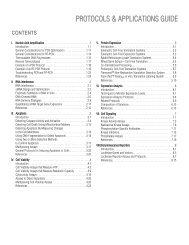2012 Promega catalogue
2012 Promega catalogue
2012 Promega catalogue
Create successful ePaper yourself
Turn your PDF publications into a flip-book with our unique Google optimized e-Paper software.
Life<br />
Science<br />
Catalog<br />
<strong>2012</strong><br />
Worldwide Contact List<br />
Section<br />
Contents<br />
Table of<br />
Contents<br />
Cell Signaling<br />
Protein Kinase Assays<br />
54<br />
ADP-Glo Kinase Assay<br />
Product Size Cat.# Price ($)<br />
ADP-Glo Kinase Assay 1,000 assays V9101 902.00<br />
For Research Use Only. Not for Use in Diagnostic Procedures.<br />
10,000 assays V9102 Pls. Enq.<br />
100,000 assays V9103 Pls. Enq.<br />
Description: ADP-Glo Kinase Assay is a luminescent kinase assay that<br />
measures ADP formed from a kinase reaction; ADP is converted into ATP,<br />
which is converted into light by Ultra-Glo Luciferase. The luminescent signal<br />
positively correlates with kinase activity. The assay is well suited for measuring<br />
the effects chemical compounds have on the activity of a broad range of<br />
purified kinases, making it ideal for both primary screening as well as kinase<br />
selectivity profiling. The ADP-Glo Kinase Assay can be used to monitor the<br />
activity of virtually any ADP-generating enzyme (e.g., kinase or ATPase) using<br />
up to 1mM ATP.<br />
The assay is performed in two steps; first, after the kinase reaction, an equal<br />
volume of ADP-Glo Reagent is added to terminate the kinase reaction and<br />
deplete the remaining ATP. In the second step, the Kinase Detection Reagent is<br />
added, which simultaneously converts ADP to ATP and allows the newly synthesized<br />
ATP to be measured using a coupled luciferase/luciferin reaction.<br />
The ADP-Glo Kinase Assay has a high dynamic range and produces a strong<br />
signal at low ATP to ADP conversion, making it well suited for screening low<br />
activity kinases such as growth factor receptor tyrosine kinases. The assay<br />
produces minimal false hits and Z´ values of greater than 0.8.<br />
Several Kinase Enzyme Systems are available. Visit<br />
www.promega.com/kinase/ to see the collection.<br />
Features:<br />
• High Signal Strength at Low ATP Conversion: Users can measure<br />
kinase activity that more closely mimics physiological conditions.<br />
• Sensitive: The assay is sensitive to low concentrations of ADP, thus requiring<br />
less enzyme than other assays.<br />
• Universal: The assay can be used with virtually with any kinase—enables<br />
researchers to screen a wider range of kinases in-house, reducing dependency<br />
on costly outsourcing of kinase selectivity profiling.<br />
• Accurate: Accurately measures ADP levels at a wide range of starting ATP<br />
concentrations; users assured that activity measured truly reflects kinase<br />
activity and produces accurate IC 50s comparable to radioactivity-based<br />
assays.<br />
• Accommodate Wide Range of ATP Levels: The assay can be used at<br />
ATP concentrations up to 1mM, important for kinases with high K m values<br />
for ATP.<br />
• Stable Luminescent Signal: Users can perform batch plate processing<br />
without need for strictly timed incubations; flexible.<br />
Storage Conditions: Store the system at –20°C. Before use, thaw all<br />
reagents completely at room temperature. Once thawed, components should<br />
be thoroughly mixed before use. Once prepared, the Kinase Detection Reagent<br />
(Kinase Detection Buffer + Substrate) should be divided into aliquots and stored<br />
at –20°C.<br />
Protocol Part#<br />
ADP-Glo Kinase Assay Technical Manual TM313<br />
For complete and up-to-date product information visit: www.promega.com/catalog
















